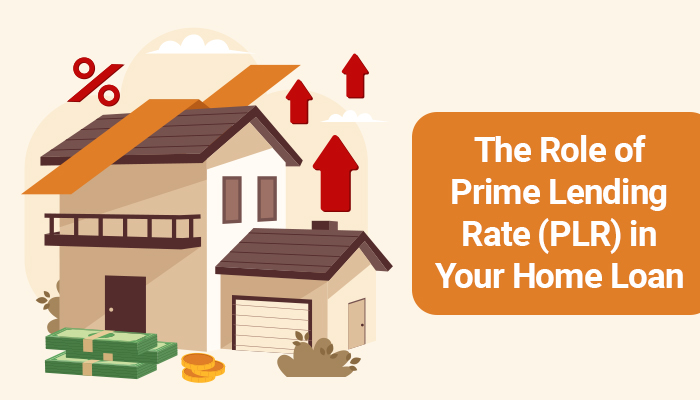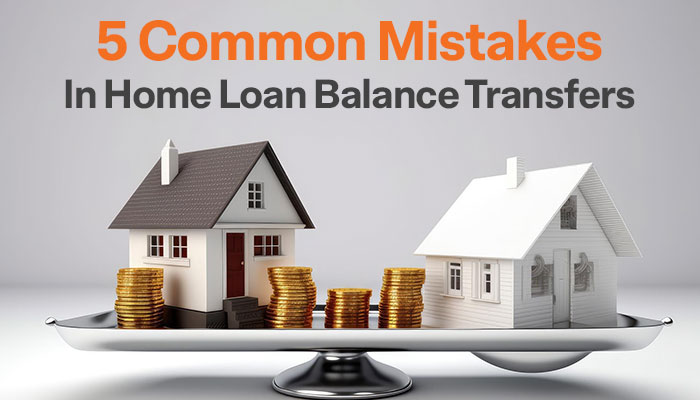Prime Lending Rate (PLR) in Home Loan: A Guide

Understanding the prime lending rate (PLR) is crucial for home loan borrowers in India. PLR serves as a benchmark for determining home loan interest rates on various loans, including home loans. Let's understand PLR and its impact on home loan borrowers.

What is the Prime Lending Rate (PLR)?
The prime lending rate (PLR) is a benchmark interest rate set by commercial banks in India. It represents the rate at which the bank is willing to lend to its most creditworthy customers.
The PLR has been a significant factor in India's banking system for decades. It has served as a reference point for home loan interest rates on various loans, including home loans.
PLR rate plays a crucial role in the home loan market. It directly influences the interest rates that banks charge to borrowers. Understanding PLR in home loans can help you make informed decisions when applying for a home loan.
How does PLR work in Home Loans?
The PLR acts as a base home loan interest rate. Banks add a margin based on the borrower’s risk profile, loan amount, and tenure. A high-risk borrower may have a significant markup added to the PLR, while a low-risk borrower may see a minimal increase over the base rate. This differential pricing allows banks to manage their lending risk while keeping loans accessible to a broad range of customers.
Banks use the PLR to calculate home loan interest rates by adding a percentage margin. For instance, if a bank’s PLR rate is set at 10%, and the borrower has a good credit score, the bank might offer a loan at PLR plus 1.5%, bringing the interest rate to 11.5%. However, if the borrower has a weaker financial profile, the bank may add a higher margin, say 3%, making the effective interest rate 13%.
The difference between PLR and MCLR
The introduction of the marginal cost of funds-based lending rate (MCLR) in 2016 was a major reform to bring greater transparency and fairness to lending rates. While PLR is determined solely by the bank and can be opaque, MCLR is calculated based on a formula that takes into account factors such as the marginal cost of funds, operating costs, and the cash reserve ratio.
The MCLR is more dynamic, adjusting periodically based on market conditions. Unlike PLR in home loans, which can remain stagnant for long periods, MCLR adjusts more frequently to reflect changes in economic conditions, making it more beneficial for borrowers. However, loans sanctioned before MCLR’s introduction may still be linked to PLR, which is why understanding the nuances of both is important.
Factors affecting Prime Lending Rate
Several macroeconomic factors impact the prime loan rate.
- Inflation: It is one of the key drivers, as higher inflation often leads to higher interest rates. When inflation rises, the Reserve Bank of India (RBI) may hike the repo rate, which is the rate at which banks borrow money from the RBI. In turn, banks raise their PLR to maintain profitability.
- Government policies: Factors such as fiscal stimulus or restrictions on lending can also cause fluctuations in the PLR. During periods of economic slowdown, the government may introduce measures to lower interest rates to stimulate borrowing, whereas, during periods of high economic growth, PLR may rise as banks become more cautious with their lending practices.
- Role of the RBI: Though it does not directly control the PLR, the RBI influences the lending rates by adjusting the repo rate and other monetary policies. When the RBI lowers the repo rate, it becomes cheaper for banks to borrow money, which often leads to a reduction in the PLR. Conversely, a hike in the repo rate leads to an increase in the PLR as borrowing costs rise for banks.

- Individual Bank Policies: Each bank sets its own PLR based on its internal policies, cost structures, and risk appetite. Some banks may have a more aggressive lending strategy and offer lower PLRs to attract customers, while others may maintain higher PLRs to protect themselves from potential risks.
Impact of PLR on Home Loan borrowers
Borrowers often have the option to choose between fixed and floating interest rates on their home loans. Fixed rates remain constant throughout the tenure, providing stability but often at a higher rate. On the other hand, floating rates are linked to the PLR rate or MCLR and fluctuate with changes in these benchmarks. While floating rates may offer lower initial interest rates, they carry the risk of future rate hikes, which can increase the borrower’s EMIs over time.

Wrapping Up
The prime lending rate is an important component in determining home loan interest rates, impacting how much borrowers pay each month. Whether you're a new borrower or managing an existing loan, understanding the role of PLR can help you navigate the loan process more effectively. For tailored solutions and expert guidance, explore the offerings at IIFL Home Loans.
FAQs
Q1. Can I switch from a PLR-linked loan to an MCLR-linked loan?
Yes, most banks allow you to switch from a PLR-linked home loan to an MCLR or repo rate-linked loan. However, this switch typically incurs a conversion fee or administrative charges.
Q2. How often does the PLR change?
The PLR can change at the discretion of each bank, but revisions typically occur in response to shifts in the RBI's monetary policies and broader economic conditions. Banks may adjust their PLR when there is a significant change in interest rates or liquidity in the economy.
Q3. Is it better to opt for a fixed or floating interest rate?
Choosing between a fixed or floating interest rate depends on your financial goals and risk tolerance. A fixed-rate offers stability and predictable EMIs throughout the loan tenure, which can be beneficial in times of rising interest rates. On the other hand, a floating rate is tied to the PLR or other benchmark rates and can fluctuate, potentially lowering your EMIs when interest rates fall, but increasing them when rates rise.
Q4. How does my credit score affect the PLR-based interest rate?
A higher credit score demonstrates financial discipline and lower credit risk, which can result in a lower markup over the bank’s PLR. This means you’ll be offered a favorable interest rate. Conversely, a low credit score may lead to a higher interest rate as lenders consider you a higher-risk borrower.
Q5. What factors should I consider when choosing a home loan lender?
When selecting a lender, consider not just the PLR, but also factors such as loan processing fees, prepayment charges, customer service quality, and loan flexibility. Comparing lenders based on these factors will help you secure the best home loan deal.
Tags
Disclaimer: The information contained in this post is for general information purposes only. IIFL Home Finance Limited (including its associates and affiliates) ("the Company") assumes no liability or responsibility for any errors or omissions in the contents of this post and under no circumstances shall the Company be liable for any damage, loss, injury or disappointment, etc. suffered by any reader. All information in this post is provided "as is", with no guarantee of completeness, accuracy, timeliness, or of the results, etc. obtained from the use of this information, and without warranty of any kind, express or implied, including, but not limited to warranties of performance, merchantability, and fitness for a particular purpose. Given the changing nature of laws, rules, and regulations, there may be delays, omissions, or inaccuracies in the information contained in this post. The information on this post is provided with the understanding that the Company is not herein engaged in rendering legal, accounting, tax, or other professional advice and services. As such, it should not be used as a substitute for consultation with professional accounting, tax, legal or other competent advisers. This post may contain views and opinions which are those of the authors and do not necessarily reflect the official policy or position of any other agency or organization. This post may also contain links to external websites that are not provided or maintained by or in any way affiliated with the Company and the Company does not guarantee the accuracy, relevance, timeliness, or completeness of any information on these external websites. Any/ all (Home/ Loan Against Property/ Secured Business Loan/ Balance Transfer/ Home Improvement Loan/ NRI Home Loan/ Home Loan for Uniformed Services) loan product specifications and information that may be stated in this post are subject to change from time to time, readers are advised to reach out to the Company for current specifications of the said (Home/ Loan Against Property/ Secured Business Loan/ Balance Transfer/ Home Improvement Loan/ NRI Home Loan/ Home Loan for Uniformed Services) loan.
 Login
Login






















